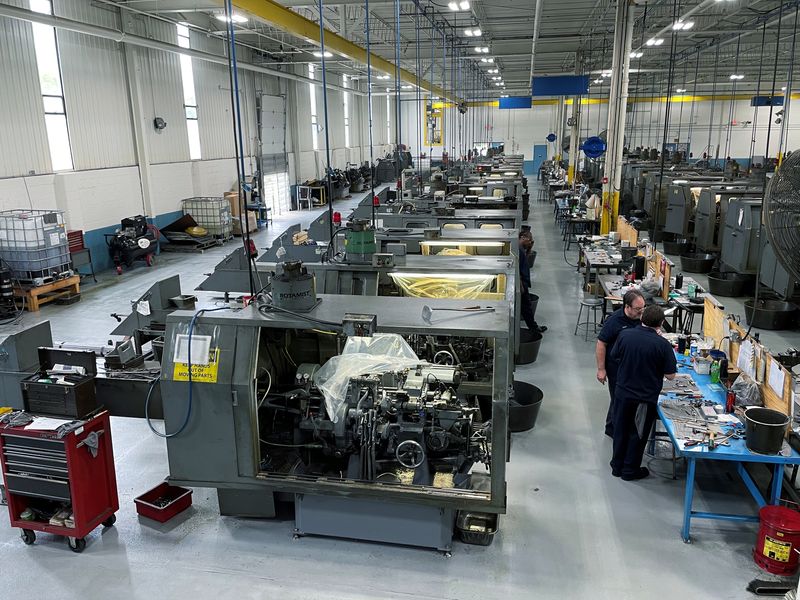By John Kemp
LONDON (Reuters) - U.S. manufacturers reported an unexpectedly widespread fall in business activity in October, postponing the sector’s exit from the prolonged downturn that began in late 2022.
Industrial energy consumption appeared to be steadying over the summer but the anticipated rebound will now be pushed back into 2024.
The Institute for Supply Management’s manufacturing purchasing managers index slipped to 46.7 (14th percentile for all months since 1980) in October down from 49.0 (24th percentile) in September.
In points terms, the decline was the largest since June 2022, and came after the index had risen in each of the three previous months, encouraging expectations that the sector’s downturn was nearing an end.
But the fall has left the index below the 50-point threshold dividing expanding activity from a contraction for 12 months running since November 2022.
The forward-looking new orders component of the index implies the downturn is likely to last for several more months.
The new orders sub-index slumped to 45.5 (9th percentile) in October down from 49.2 (20th percentile) in September.
Chartbook: U.S. manufacturing and energy use
In duration, the current downturn already has more in common with a cycle-ending recession than with a mid-cycle slowdown.
Since 1948, recessions have lasted for 11 months or more, while mid-cycle slowdowns have tended to last for eight months or fewer.
If the current downturn proves to be a mid-cycle slowdown, it has already lasted longer than any other since the Second World War.
But the downturn has also been unusually shallow and accompanied by the barest slowdown (if any) in the much larger services sector.
NOT JUST AUTO STRIKES
Some of the decline in manufacturing is probably attributable to industrial action at the three largest automakers in October.
Strikes at car and truck plants are likely to have a widespread impact on manufacturing activity given their large supply chains. Even so, they probably cannot explain the scale and breadth of the sudden slowdown in October.
Thirteen different industrial sectors reported contraction last month, including: printing, textiles, electrical equipment, machinery, fabricated metals, wood products, computers, furniture, paper, primary metals, chemicals and miscellaneous products, as well as transport equipment.
Only two sectors reported growth: food and drink, and plastics and rubber.
EXPANSION POSTPONED?
The sudden weakness in manufacturing came after activity had appeared to be nearing a cyclical trough in the third quarter, after sustained weakness in the first and second quarters.
Energy consumption by industrial users steadied over the third quarter, which was consistent with the worst of the manufacturing downturn being over.
The volume of diesel and other distillate fuel oils supplied to the domestic market rose marginally in three months from June to August compared with the same period a year earlier.
More than three-quarters of all distillates supplied are used in freight transport and manufacturing so distillate use is closely correlated with changes in the industrial cycle.
The volume of distillate supplied increased in the three months between June and August 2023 for the first time since the three months from September to November 2022.
Sales of electricity to industrial customers continued to decline in the most recent three-month period from May to July, but also at some of the slowest rates since the three months from September to November 2022.
The stabilisation of both diesel and industrial electricity sales in the summer was consistent with manufacturing activity steadying ahead of a renewed expansion.
Because the industrial downturn has been long but shallow, distillate inventories remain well below the long-term seasonal average.
Return to expansion would likely cause diesel stocks to deplete rapidly and put upward pressure on industrial prices quickly.
Tight energy supplies have been a major source of inflation risk and one reason interest rate traders have expected the Federal Reserve and other major central banks will have to keep overnight rates higher for longer.
But the renewed softness in manufacturing evident in October is likely to push back both the expected recovery and re-emergence of inflation.
Related columns:
- U.S. manufacturing rebound will stretch diesel supplies(October 5, 2023)
- Global diesel shortage boosts prices (September 13, 2023)
- Prolonged U.S. manufacturing slowdown barely dents energy use (September 5, 2023)

- U.S. diesel prices surge anticipating a soft landing (August 11, 2023)
John Kemp is a Reuters market analyst. The views expressed are his own. Follow him in X: https://twitter.com/JKempEnergy